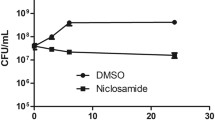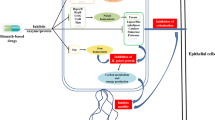Abstract
Helicobacter pylori infection is causally related to atrophic gastritis, and it may also be associated with peptic ulcer and gastric carcinoma. Eradication ofH. pylori is recommended in patients with such diseases, especially in those with peptic ulcer. A new potent proton pump inhibitor, E3810, had an antibacterial effect onH. pylori, as has been reported for omeprazole and lansoprazole, two other proton pump inhibitors. The minimum inhibitory concentration of E3810 was 1.57–3.13 μg/ml, lower than that of omeprazole or lansoprazole. To clarify the mechanism of the antibacterial effect of E3810, we analyzed the characteristics of E3810 binding toH. pylori. Scatchard plot analysis of this binding showed a curvilinear profile, indicating the presence of several molecules with different affinities to E3810 onH. pylori. The binding capacity of E3810 toH. pylori was calculated to be about 2×106 sites/cell. These results suggested that E3810 has an antibacterial effect againstH. pylori and that the effect may be mediated through direct binding toH. pylori.
Similar content being viewed by others
References
Warren JR, Marshall B. Unidentified curved bacilli on gastric epithelium in active chronic gastritis. Lancet 1983;I:1273–1275.
Blaser MJ. GastricCampylobacter-like organisms, gastritis, and peptic ulcer disease. Gastroenterology 1987;93:371–383.
Marshall BJ, Goodwin CS, Warren JR, et al. Prospective double-blind trial of duodenal ulcer relapse after eradication ofCampylobacter pylori. Lancet 1988;II:1437–1442.
Rauws EAJ, Tytgat GNJ. Cure of duodenal ulcer associated with eradication ofHelicobacter pylori. Lancet 1990;335:1233–1235.
Hentschel E, Brandstätter G, Dragosics B, et al. Effect of ranitidine and amoxicillin plus metronidazole on the eradication ofHelicobacter pylori and the recurrence of duodenal ulcer. N Engl J Med 1993;328:308–312.
Helicobacter pylori peptic ulcer disease. National Institutes of Health Consensus Development Conference; 1994 Feb 7–9; Bethesda. Bethesda: National Institutes of Health, 1994.
Borody T, Cole P, Noonan S, et al. Long-termCampylobacter recurrence post-eradication (abstract). Gastroenterology 1988; 94:A43.
Iwahi T, Satoh H, Nakao M, et al. Lansoprazole, a novel benzimidazole proton pump inhibitor, and its related compounds have selective activity againstHelicobacter pylon. Antimicrob Agents Chemother 1991;35:490–496.
Adamek RJ, Wegener M, Labenz J, et al. Medium-term results of oral and intravenous omeprazole/amoxicillinHelicobacter pylori eradication therapy. Am J Gastroenterol 1994;89:39–42.
Fujisaki H, Shibata H, Oketani K, et al. Effects of the proton pump inhibitor, E3810, on gastric secretion and gastric and duodenal ulcers or erosions in rats. Drug Invest 1991;3:328–332.
Scatchard G. Some physical chemical aspects of “plasma extenders”. Ann NY Acad Sci 1952;55:455–464.
Labenz J, Rühl GH, Bertrams J, et al. Medium- or high-dose omeprazole plus amoxicillin eradicatesHelicobacter pylori in gastric ulcer disease. Am J Gastroenterol 1994;89:726–730.
Van Zanten SJO, Goldie J, Hollingsworth J, et al. Secretion of intravenously administered antibiotics in gastric juice: Implications for management ofHelicobacter pylori. J Clin Pathol 1992;45:225–227.
Hunt RH. pH and Hp-Gastric acid secretion andHelicobacter pylori: Implication for ulcer healing and eradication of the organism (editorial). Am J Gastroenterol 1993;88:481–483.
Mauch I, Bode G, Malfertheiner P. Identification and characterization of an ATPase system ofHelicobacter pylori and the effect of proton pump inhibitors. Am J Gastroenterol 1993;88:1801–1802.
Nagata K, Satoh H, Iwahi T, et al. Potent inhibitory action of the gastric proton pump inhibitor lansoprazole against urease activity ofHelicobacter pylori: Unique action selective forH. pylori cells. Antimicrob Agents Chemother 1993;37:769–774.
Segal ED, Shon J, Tompkins LS. Characterization ofHelicobacter pylori urease mutants. Infect Immun 1992;60:1883–1889.
McGowan CC, Cover TL, Blaser MJ. The proton pump inhibitor omeprazole inhibits acid survival ofHelicobacter pylori by a urease-independent mechanism. Gastroenterology 1994;107: 738–743.
Author information
Authors and Affiliations
Rights and permissions
About this article
Cite this article
Hirai, M., Azuma, T., Ito, S. et al. A proton pump inhibitor, E3810, has antibacterial activity through binding toHelicobacter pylori . J Gastroenterol 30, 461–464 (1995). https://doi.org/10.1007/BF02347561
Received:
Accepted:
Issue Date:
DOI: https://doi.org/10.1007/BF02347561




